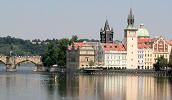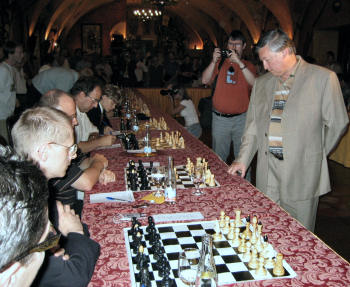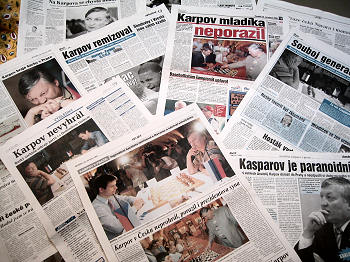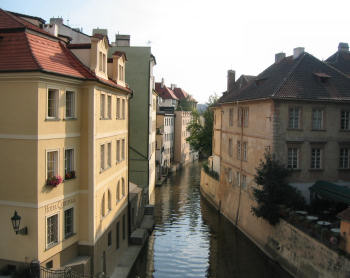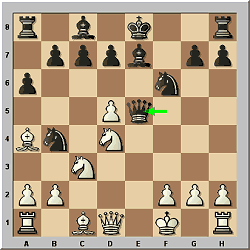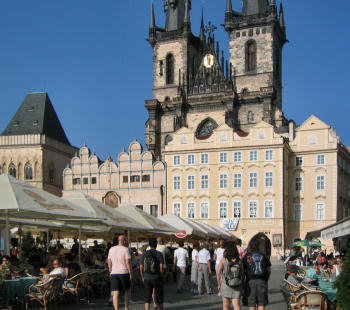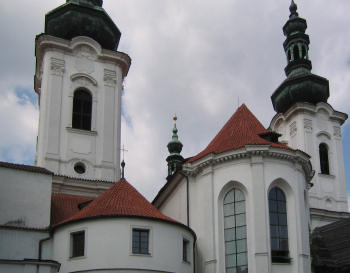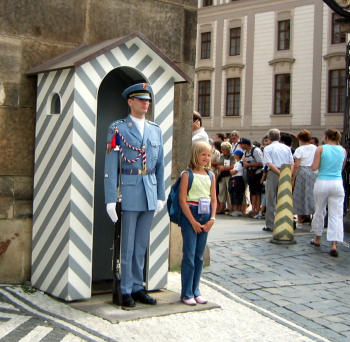CEZ Chess Trophy
For the third time in the last three years the Prague Chess Society, chaired by Pavel Matocha, organized a two-game match for the 20-year-old Czech champion David Navara.
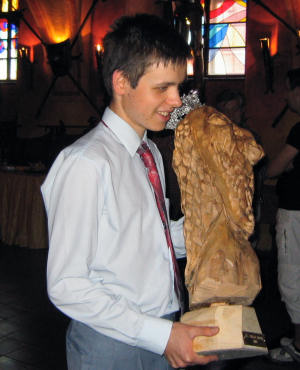
David Navara with the CEZ Chess trophy
In 2003 Navara beat Viktor Korchnoi 1½:½, but last year lost to Alexei Shirov with the same score. This year they brought in former world champion Anatoly Karpov. The Czech grandmaster declined an advice to engage Karpov in a sharp tactical fight and by playing a solid positional chess steered the match into a 1-1 tie. Genna Sosonko and I provided commentaries for the public. [Replay the games]
The President's visit
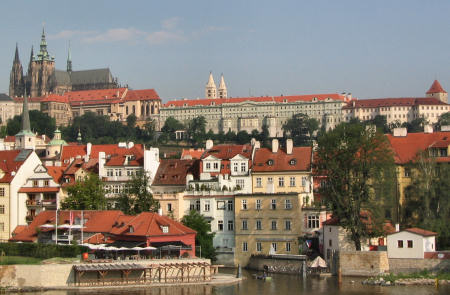
Czech president Vaclav Klaus spends most of his time at the Prague castle (in the picture on the top with St. Vitus’s cathedral, below at the river level is Kampa).

The president visited the CEZ Chess Trophy festival on Saturday, June 16. Before making the ceremonial first move in the second game Karpov-Navara, he came to the commentary hall. We discovered we had common early successes in chess. Both of us were champions of our high schools. Because of the age difference we never met over the board.
On his travels Vaclav Klaus likes to solve chess puzzles or play over games from magazines in his head. Once we flew together from Prague to Washington, D.C. Upon our arrival the president showed me that he was studying my game with Eduard Gufeld which won the brilliancy prize at the 1962 Student Olympiad in Marianske Lazne. His two sons play the game as well.
The president made an opening move in the second game with Karpov having the white pieces.

Anatoly Karpov, seeking presidential advice: "Shall I play 1.Nf3?"
Big Blitz Show
The chess festival began on Thursday, July 14, at the Club Fortuna, formerly known as the Palace "U Novaku," with a 12-game blitz match between Navara and the top-rated Slovakian grandmaster Sergei Movsesian.

Blitz match between Sergei Movsesian and Czech champion David Navara
For the first time betting on chess was possible in the Czech Republic through the Fortuna betting company. Movsesian was a clear favorite among the bettors who put $1 million Czech Crowns (roughly US $40,000) on the match. Fortuna made money when Navara being two points down before the last two games tied the score 6-6.

The blitz match Movsesian vs Navara ended in a surprising 6-6
Download all the games in PGN
Sweating out a chess move
Dominik Hasek, one of the best goalies in ice-hockey history, commanded a long-lasting applause after he made an opening move at the blitz match Navara-Movsesian. In the National Hockey League (NHL) Hasek won twice the Hart Trophy (1997, 1998) for the most valuable player and became six-time Vezina Trophy winner for the best goalie of the season.

Dominik Hasek, the superstar goalie of the Czech national ice-hockey team
The Czechs love him for his acrobatic work in the goal during the 1998 Winter Olympiad in Nagano, making it possible for the Czech national hockey team to win the gold medals. When Vladimir Kramnik mentioned that he used a defensive strategy of the Czech national team to defeat Garry Kasparov in London in 2000, he failed to say that Hasek was the key to the team’s success and its last defensive barrier. Now age 40 he is still going to play in the NHL for the Ottawa Senators.
On the ice Hasek is an aggressive player. On the chessboard he prefers order. He loves the Italian Game, the peaceful "Giuoco Piano." We would play chess by e-mail, to break the monotony of his NHL travel. His style on the ice is original, hard to imitate and describe. He would tease attackers by opening big holes where they could score, but when they send the puck there the gaps would quickly close. My son once asked him how to improve his goalie skills. "Make sure you sweat a lot," Hasek replied.
The best ice-hockey goalie among chessplayers could have been GM Vlastimil Hort. He played for a junior team in his hometown of Kladno before deciding on chess.
Prague Olympiad and Salo Flohr
The Palace "U Novaku" was a site of the Chess Olympiad in 1931. It was possible to fit in all 19 Olympiad teams 75 years ago. The United States (Kashdan, Marshall, Dake, Horowitz, H. Steiner) won the event ahead of Poland (Rubinstein, dr. Tartakover, Przepiorka, Makarczyk, Frydman). The world champion Alexander Alekhine won the first board with a 13 1/2 - 4 1/2 score. Czechoslovakia (Flohr, Gilg, Rejfir, Opocensky, Skalicka) got the bronze medal.
<img data-cke-saved-src="http://en.chessbase.com/portals/4/files/news/2005/flohr01.jpg" src="http://en.chessbase.com/portals/4/files/news/2005/flohr01.jpg" style="float: left; margin-right: 10px; margin-bottom: 5px; width=" 150"="" height="191">Salo Flohr was on the way to become one of the best players in the world. In 1937 he was named the challenger for Alekhine’s world title, but the match was later aborted.
Flohr was one of the most skillful simultaneous players, on par with Jose Raul Capablanca. Both players met in Prague on February 5, 1935, and played an alternate (or tandem) exhibition. It is estimated that Flohr played over 30,000 simultaneous games in his career. I worked with Flohr on the coverage of the 1966 world championship match Petrosian-Spassky for a Czech daily. His phone calls from Moscow often resembled fashion show reports: I always knew what tie Petrosian was wearing every day. He was an excellent reporter long before he became a world-class player.
Happy Ending
After the match Karpov-Navara, Bessel Kok invited all participants to his house and a dinner in a fine French restaurant.

From left to right: Pavel Matocha (CEZ Chess Trophy organizer), Mariette Gilson, Genna Sosonko, cow, Bessel Kok, David Navara, Anatoly Karpov, Lubos Kavalek.
Kok and Karpov are considering running for the FIDE presidency next year. They can even forge a strong alliance to clean out the FIDE house.
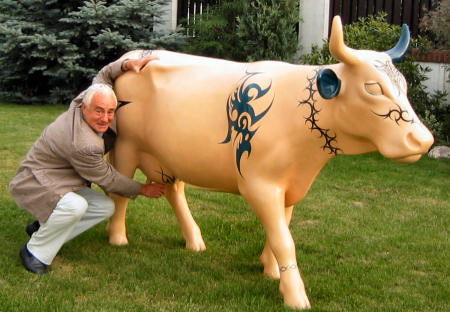
Hard-working Genna Sosonko enjoyed more than commenting chess moves. The cow was exhibited in the Cow parade, a charity event organized in Prague by Bessel Kok. Some 200 cows, painted by Czech celebrities, were displayed all over the city. They were later auctioned. The cow of former president Vaclav Havel was the most desired animal.
No Chess Column
Karpov was not done. On Sunday, July 17, he played a simultaneous exhibition at the Kampa hotel against selected managers and celebrities. He won 22 games, drew three.
The media coverage of the chess festival was extensive.
But there was shocking news: they cut chess columns in all newspapers. I still remember many chess columns when I had a weekly Czech column in Nedelni noviny (Sunday’s newspaper) in 1999-2000.
A Healthy Stroll
Let's have a little walk through some of the most picturesque spots of the city. It is better than to take a sightseeing car.
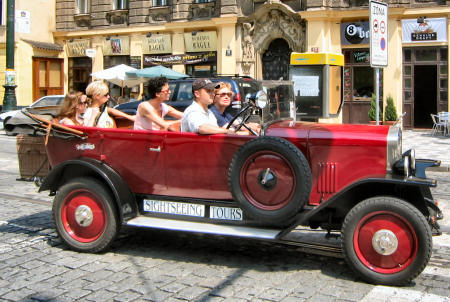
Hopefully we don’t meet many tourists. They are no pictures of beautiful Czech girls in this report. You have to come to Prague and see them in person. A fair warning: you may come to Prague, see the girls and stay in the city for the next ten years. Ask Bessel Kok.
Charles Who?
What may strike you immediately is the name Charles. It is attached to a university, a square, a street, a bridge or even a castle outside Prague. Here is a restaurant at the corner of Charles Street.
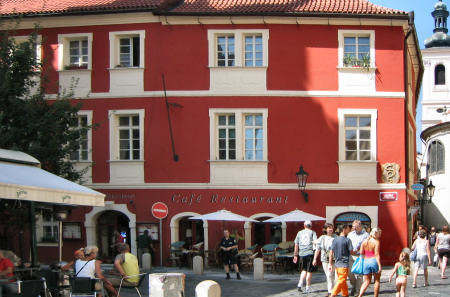
It comes from the Czech monarch Charles IV. Garry Kasparov, with a different take on world’s history, may argue that this man did not exist under his widely known name. "You can name him as you wish," he once told me.
But there are other historians who documented that Charles the Fourth (1316-1378) reigned in Prague's Golden Age. He became the Bohemian king in 1346 and the Holy Roman Emperor in 1355. He founded Charles University (Carolinum) in 1348, built several fine churches and monasteries in Gothic style. In 1344, on his order, work began on St. Vitus’s cathedral, one of Prague’s most visible landmarks. Charles IV also built a beautiful bridge and, as the Czechs are being taught in schools, with the help of eggs.....
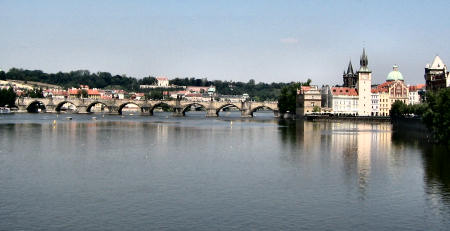
The Charles Bridge, the oldest in Prague, is one of the most popular bridges in the world. Early morning is the best time to go there before it gets crowded. It connects the Old Town (on the right) to the Little Quarter (on the left).
The legend has it that Charles IV begun to build it on July 9, 1357 at 5:31 AM. The numbers 135797531 form a pyramid (with number 9 on the top). They represent the year (1357), the day (9), the month (7), the hour (5) and the minutes (31).
Looking from the Charles Bridge on the Devil’s Creek that together with the river Vltava surrounds the Kampa island, Prague can be mistaken for Venice.
A Room with a View
Some people are lucky. They are born into a place with a magnificent view. This is what my wife saw every day from her fifth-floor apartment when she lived in Prague.
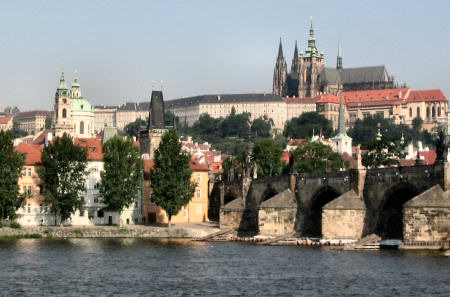
Café Slavia

A tram passes Cafe Slavia, an important literary café where chess was played in the past. In the 1920s it was a home of the most prestigious Czech chess club "Dobrusky." It moved there from Café Louvre, just 24 houses down the same street.
Brilliant Mind, Rotten Body
In the year 1958, at the age of 15, my chess career took off. I played a lot and began to skip scout meetings (scouting was officially forbidden at that time, but we hid under a sports organization name). One day someone sent me a message: "You can’t have a brilliant mind sitting in a rotten body." Never mind the mind, I thought, let’s take care of the body first, and I returned to my scout friends. Some of them had very successful careers like the top Czech jazzman Jiri Stivin or the current president of the Czech Academy of Science, Vaclav Paces. We had a lot of fun in 1958.

Sometimes we would take boats and paddle through sluice gates on the Vltava river like the one you can see from Charles Bridge.
The Year of Fischer and Tal

A view to the southwest to Smichov, where the 1958 Prague championship final was played. In the summer of that year Bobby Fischer would make it to the Candidates tournament from the Interzonal in Portoroz. It was also a time of wild chess influenced by the rise of Misha Tal. Chaos reigned in a game against a colourful Prague master who is now in his 70s.
Kavalek,L - Ratolistka,J [C70]
Prague ch (12), 1958
1.e4 e5 2.Nf3 Nc6 3.Bb5 a6 4.Ba4 f5. A popular variation against the Spanish at that time. 5.d4 exd4 6.exf5. 6.e5 is the right choice. Trying to leave the theoretical path, I created problems for myself. 6...Qe7+ 7.Kf1 Qc5 8.c3 Qxf5 9.cxd4 Be7 10.Nc3 Nf6 11.d5 Nb4 12.Nd4 Qe5.
13.Ne6! Kf7 14.Nf4 g5 15.Nh5 Qf5 16.h4 Bc5 [16...Nd3] 17.f4 gxf4 18.Nxf6 Kxf6 19.Rh3 Rg8 20.Qf3 d6 21.a3
The knight is caught and black loses, but not without fight. 21...Qxh3 22.gxh3 Bxh3+ 23.Qxh3 Rg1+ 24.Ke2 b5 25.Ne4+ Kg7 26.axb4 Bxb4 27.Be3 Rxa1 28.Bd4+ Kf8 29.Qf5+ Ke8 30.Nf6+ Kf7 31.Qe6+ Kg6 32.h5+ Kg5 33.Nxh7+ Kxh5 34.Qf5+ Kh6 35.Qg5+ Kxh7 36.Qg7# 1-0. [Click to replay].
Eat, Drink...
Outside restaurants and cafes are everywhere. In little streets like this one near the Charles street
or in the Old Town square
Petrin Hill
Petrin Hill is a good place to see the city and you don't see many tourists there.
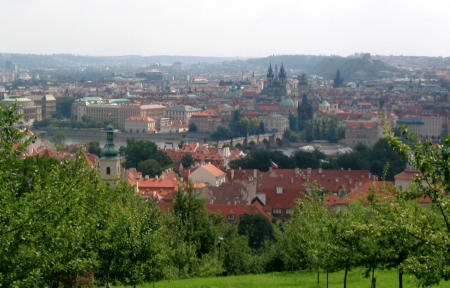
The view from Petrin Hill at Charles Bridge and Old Town. In front is the Little Quarter and the Kampa island where the CEZ Chess Trophy match Karpov - Navara took place. In 1958 I used to walk over Petrin Hill on my way to Wallenstein Palace, where we played the Prague championship semifinals. Today the Palace houses the Czech Senat.
By walking around Petrin Hill you come to Strahov Monastery that houses a famous 800-year-old library, one of the finest in the country.
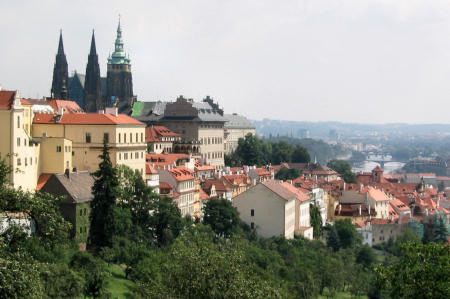
From there is a nice view towards Prague Castle, St. Vitus’s cathedral and over the rooftops to the Vltava river.
To the Prague Castle

On the way to the Prague Castle you can visit the beautiful Loreto. Built in 1626, the Church of Loreto is an important religious building and a highly regarded example of architectural design. Enclosed in the large Baroque tower is a set of 27 bells.
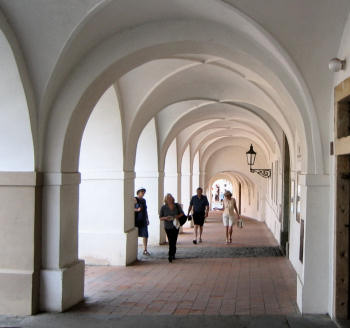
You can hide from the sun in an archway
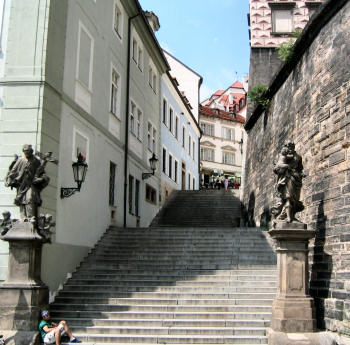
... or take a street with stairs
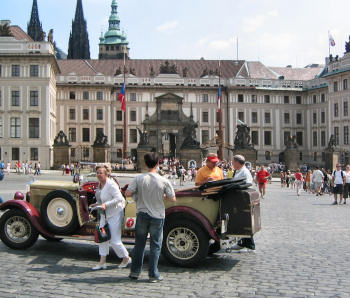
And suddenly you arrive at the castle’s gates
The flag right on top of the roof is president’s flag. It is taken down when the president leaves the country. The castle is protected by guards. Here are two of them.
The guard's uniform was designed by Theodor Pistek, who worked on many Milos Forman's movies and won an Oscar for his costume design in the film "Amadeus."
1000 or 100? Who is counting?
Prague is called the city of a thousand spires, but the people of Prague believe that there are only 100 of them.
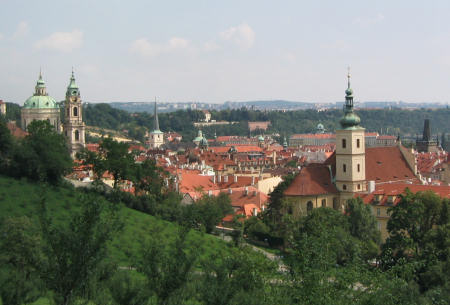
Spires and red rooftops belong to the city
Lubomir Kavalek
Born August 9, 1943 in Prague, Czechoslovakia. Since 1970 lives in the USA. International grandmaster since 1965, rated in world's Top Ten in the 1970s. Champion of Czechoslovakia 1962 and 1968. U.S. champion 1972 (with S. Reshevsky and R. Byrne), 1973 (with J. Grefe) and 1978.
First places in international (all-play-all) tournaments: Split 1964, Varna 1965 and 1967, Zwolle 1967, Amsterdam 1968, Hague 1968, Dieren 1969, Caracas 1970, Netanya 1971 and 1973, Lanzarote 1973, Montilla 1973, Bauang 1973, Solingen 1974, Bochum 1981. In 1978 defeated GM Ulf Andersson in a match in Washington, D.C. 6.5-3.5. Placed first in numerous open Swiss tournaments.
Played mostly the top board for the U.S. team at Chess Olympiads from 1972-1986, winning one gold and five bronze medals. Played in 1964 and 1966 for Czechoslovakia. As a leading player on the Solingen team he won the European Club championship in 1976 and 10 national titles in German Bundesliga between 1969-1990.
Won several brilliancy prizes. The most famous game against Eduard Gufeld from the Student Olympiad in Marianske Lazne 1962 was ranked as number seven in Andrew Soltis's "The 100 Best Chess Games of the 20th Century."
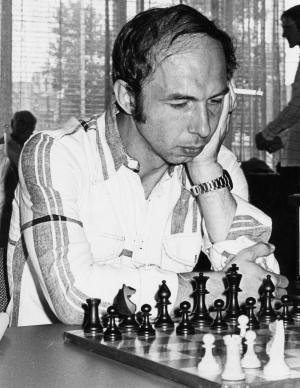
Kavalek at the 1975 IBM tournament in Amsterdam
Coach/analyst for the team of World against the U.S.S.R. in London 1984, Bobby Fischer (world championship match Reykjavik 1972), Mark Diesen (world junior champion 1976/77), Yasser Seirawan (Toluca Interzonal 1982), Robert Huebner (1983 Candidates), Eugene Torre (Biel Interzonal 1985), Nigel Short (1990-1993).
Chief organizer of the prestigious 1979 Montreal Tournament and the 1987-1988 World Cup Grand Prix. Executive director of the Grandmaster Association (1987-1993). Member of FIDE players committee in 1984. Inducted to the Chess Hall of Fame in 2001.
Award winning chess columnist for the Washington Post since 1986. Editor-in-Chief RHM Press chess publishing (1973-1989). Author of "Wijk aan Zee Grandmaster Chess Tournament 1975" and "World Cup Chess" (Bloomsbury 1990). Between 1960-2005 his chess magazine articles have appeared in eight different languages. He wrote in English mostly for Chess Life and British Chess Magazine.
